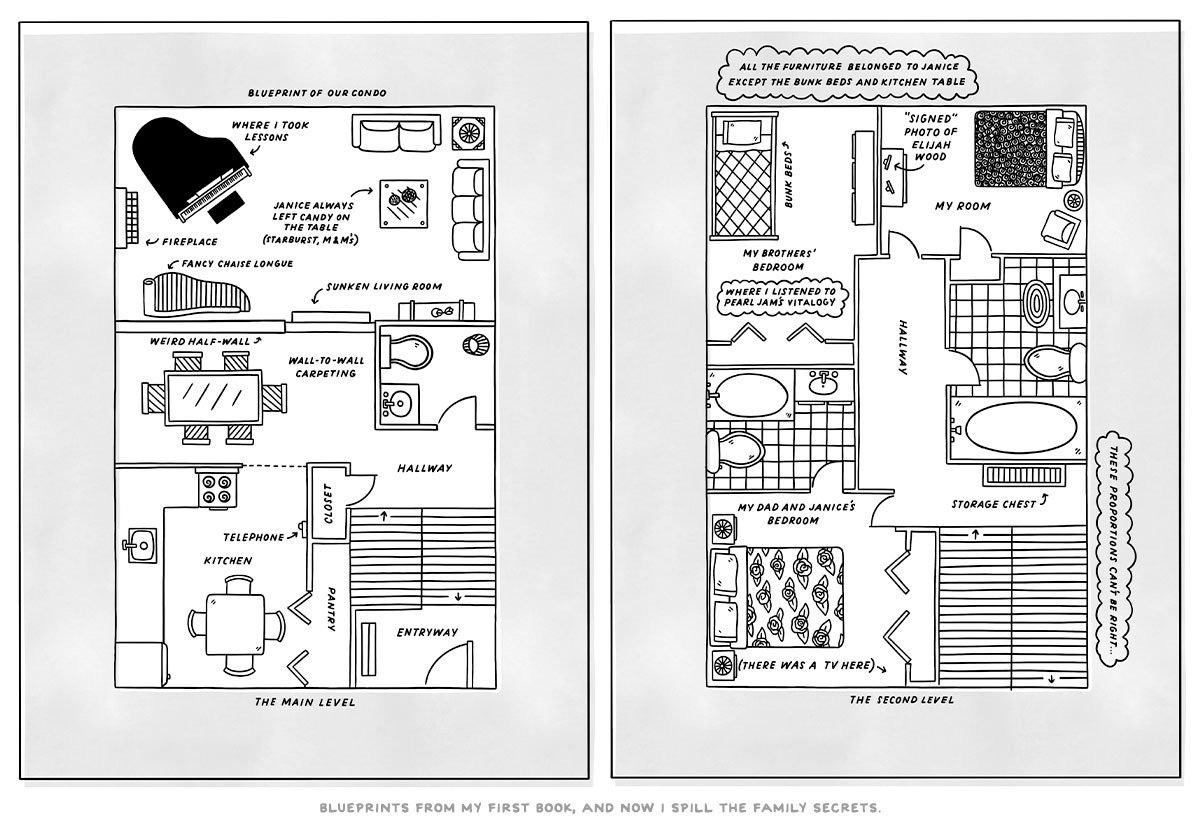First Things First
Making an Outline
At this early stage of making my second illustrated memoir, A Brief History of My Affairs, I’m working on the book structure (or outline). Since this story takes place in chronological order, with flashbacks and flash-forwards every now and again, the outline is essentially a timeline. Still, there are decisions to be made (what to leave out, what to leave in, when to begin) and so what seems simple at first—write down the order of things—always turns out to be more complicated than I originally anticipated.
If I were building a house, this would be the blueprint phase. What rooms need to be built and where? How big should each room be? Where do we want to spend time or pass quickly through? How do we arrange the house in a thoughtful way, so residents move through logically, with ease and delight?
Making the timeline is one of my favorite parts of the process because researching it corrects the sequence of my memories, shifts light on events, and gives me a new understanding of the past. For instance, I initially thought this book would begin in the spring of 2011, at the end of graduate school, because it was later that year that—for lack of a better term—shit hit the fan for me. One relationship blew up and another started, etc. (Those juicy deets are in the book.) But after my book was acquired by Pantheon and I settled down with the timeline, I kept wondering what led up to the moment of implosion? Were there earlier signs? Could I have predicted what happened? What was the larger context for what happened? I ended up further back in time, in 2008, at the start of graduate school, where I went to escape another city, another relationship. By reflecting on the timeline, I was able to understand that what happened in 2011 was part of a broader pattern in my life, not a single, explosive event.
To begin, I start with general dates and later move into detail. For the sake of brevity, I’ll use an example from the first part of my book. The initial timeline looked like something like this:
May 2011 - Grad school ends
November 2011 - Relationship begins
February 2012 - Relationship ends
Once I established the broad strokes, I began researching the details. How do I do this? Well, if you read my first book, you know that—even though I wish this weren’t true—I’m a person who saves…a lot. Text messages, emails, photos, letters, old art projects, diaries, ticket stubs, phone logs. (Apologies to all of my family members and former lovers. Apologies also to my very patient husband, who once thoughtfully suggested I “let it all go” in a bonfire in the back yard. One day, my love. One day.) I sift through all of this old memorabilia (and feel my feelings), and take notes. I look for specific dates and times, any additional information I can gather from photos or letters. Public records are a great source, and since this book begins in grad school, the online university archives were helpful. With this groundwork, my timeline came into focus (sources are in the parentheses):
4/21/2011 - MFA thesis show in Tucson (catalog)
5/11/2011 - Move back to NYC (email)
5/18/2011 - Don Quixote at Lincoln Center (text messages)
8/23/2011 - Earthquake in NYC (newspapers)
11/10/2011 - Visit to Tucson (text messages)
11/12/2011 - Relationship begins (details in the book)
11/18/2011 - Correspondence ensues (letter, emails)
[Other things happen]
2/6/2012 - Relationship ends (emails)
With research, dates become specific and the order of events is clear. After writing down every bit of information I can find, the culling begins. What’s important? What should be in scene? What should be in a sentence or in the marginalia? What can be left out? At this point, with a better understanding of the nuances of the past, I rewrite the timeline with what seems like the most interesting moments that I want to show in scene:
MFA thesis show
Arrive at the apartment in Hell’s Kitchen
Start new job
Date to see Don Quixote
Argument
Earthquake at ground zero
Dinner in Tucson
So, my timeline moves from General > Specific > Summary of Scenes. I’ll then extrapolate this out for the entire book in order to get a sense of the narrative arc. Once I have a grasp of the narrative, I can refine the plot and adjust for momentum.
If you’re working on a graphic memoir, I’d suggest making the timeline first. This will show you what the book is, help you figure out where you want to go (in narrative terms) and how you’ll get there. Below is a prompt to help you get started. Note that the outline is an extremely practical tool. You don’t have to get into the why of things quite yet, just the what.
What specific event do you want to write about?
What happened?
Generally, when did it happen?
Using sources for evidence, when did each specific moment happen?
Are there any other relevant events, in your life or in the culture?
What is necessary for the telling?
What can be cut?
What’s the most interesting way to say it?
Refine, refine, refine.
Next up, I’ll get into the often horrendous but sometimes magical practice of writing an illustrated memoir. If you have a specific question you’d like me to answer, send me an email. Thanks for reading.



Enticing! More, more! Can't wait for the next installment.
I love how creating a timeline helped you discover that you needed to change the timeline! This is such a smart and helpful post. I'm excited to be along for your graphic memoir-making journey!